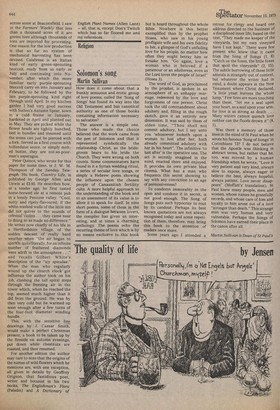Country life
Hedgehogs
Denis Wood
Driving out to dinner the other night, we saw a hedgehog begin to cross the road in front of us. Fortunately for once no projectile was homing on our back lights and we were easily able to stop and see him to the other side.He was a sleek well-covered little creature having obviously begun to accumulate deposits of fat against the impending hibernation, which however, was not yet; many do not lie up until the end of December. Hedgehogs have few successful natural predators, although occasion al ones are pounced on by badgers before the can curl up. How much they are still cooked and eaten by gipsies I do not know, but by far their greatest menace is the motor can In this connection I was interested to read, in Veterinary Practice of September 15, an account of studies made in Austria by the Institute of Comparative Behaviour Research in the Austrian Academy of Sciences on gamewarning reflector signs, used to reflect headlamp beams back into the adjoining countryside. These beams are coloured red and present an alarm signal to animals deterring them from crossing past the visual barrier. On a test section there was a reduction of 80 per cent in wild life accidents. Although the reflectors are said not to be expensive their first object so far is to protect game, and it will be a long time before they are introduced here in the interests of such small beer as hedgehogs, or even weasels, on their lawful occasions of maintaining a balance of wild-life population. But many of these would be spared if the compulsive habit of driving fast were to be abated.
It is hard to get Calabrese in shops but the other day I came
across some at Beaconsfield. I saw in the Farmers' Weekly that less than a thousand acres of it are grown here although thousands of tons are imported for processing. One reason for the low production is that so far no system of mechanical harvesting has been devised. Calabrese is an Italian kind of early green-sprouting broccoli, ready from as early as July and continuing into November, after which the more familiar early purple-sprouting broccoli carry on into January and February, to be followed by the late purple-sprouting kind right through until April. In my kitchen garden I had very good success with Sutton's Autumn Spear, sown in a cold frame in January, hardened in April and planted out in May. They are picked while the flower heads are tightly bunched, tied in bundles and steamed until the stems can just be pierced with a fork. Served as a first course with hollandaise sauce, or simply melted butter, they are not-so-poorman's asparagus.
Peter Quince, who wrote for this paper for some time, is J. W. M. Thompson of the Sunday Telegraph. His book, Country Life, is published by George Allen and Unwin at £3.95. He describes how, at a tender age, he first tasted home-brewed ale at a remote pub in a lonely Pennine valley. "Cool, nutty and ripely-flavoured; if the white-washed walls of the little inn did not quiver to the sounds of celestial violins. .. they came near to doing so as made no difference." He writes now chiefly of his life in a Hertfordshire village, of the sudden descent of really hard weather when "the air began to Thenumber of feathered diamonds The . quality of life were adrift in the atmosphere. . ."
and recalls Gilbert White's description of the "icy spiculae." When the man who regularly wound up the church clock got influenza the author took on his job, climbing the tall spiral steps' through the freezing air in the tower which, when he reached the top, seemed much higher than it did from the ground. He was by then very cold but he warmed up soon enough after a few turns of the four-foot diameter winding handle.
This, with the sensitive line -- drawings by J. Caesar Smith, would make a perfect Christmas present, a book to be taken up by the fireside on autumn evenings, put down while chestnuts are roasted, and then resumed.
For another edition the author may care to note that the origins of the names of wild flowers which he mentions are, with one exception, all given in details by Geoffrey Grigson, that fastidious poet, writer and botanist in his two books, The Englishman's Flora (Paladin) and A Dictionary of
English Plant Names (Allen Lane) — all, that is, except Don's Twitch which has so far floored me and my references.



































 Previous page
Previous page